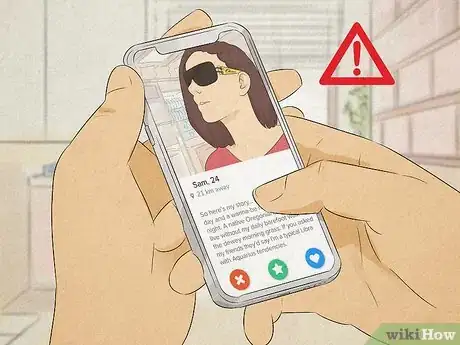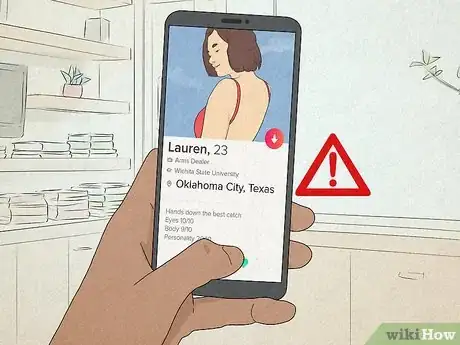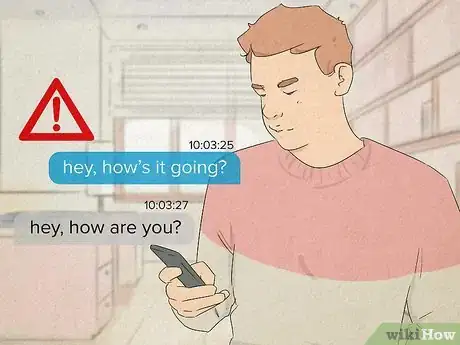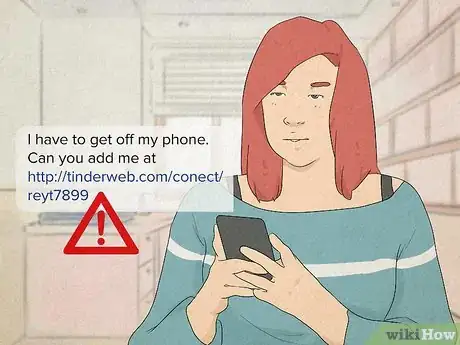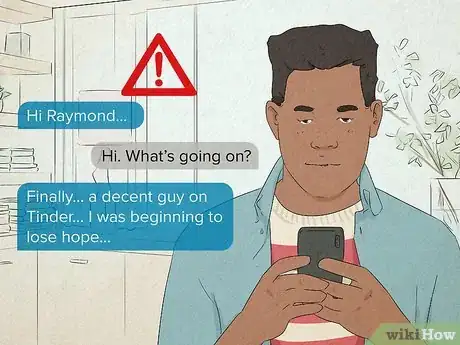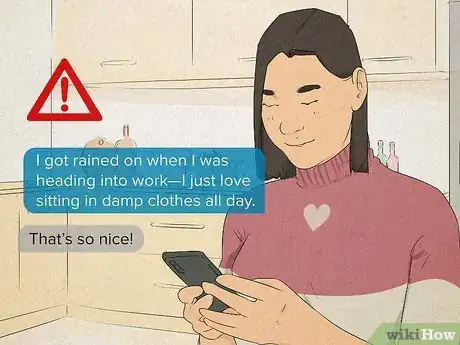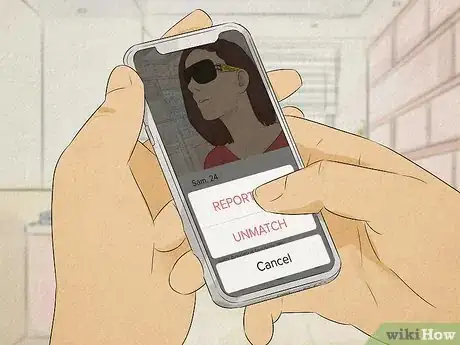This article was co-authored by wikiHow staff writer, Janice Tieperman. Janice is a professional and creative writer who has worked at wikiHow since 2019. With both a B.A. and M.A. in English from East Stroudsburg University, she has a passion for writing a wide variety of content for anyone and everyone. In her free time, you can find her working on a new crochet pattern, listening to true crime podcasts, or tackling a new creative writing project.
This article has been viewed 68,112 times.
Learn more...
Tinder can be a great way to meet new people; unfortunately, this is a lot easier said than done when bots create over half of Tinder’s web traffic.[1] X Research source Tinder bots are fake profiles that are managed by computer programs—in many cases, Tinder bot profiles will send out malicious links or URLs to phishing scams.[2] X Research source Not to worry—with a few simple tips and hacks, you’ll be able to identify any future robotic matches on Tinder and swipe left.
Steps
Scan the profile for unrealistic, high-quality pictures.
-
If the profile looks too great to be real, then it probably is. Bots tend to use studio-quality pictures on their profiles, or steal pictures from other social media accounts. If the photos look like they could’ve come out of a magazine, then the profile is probably a bot.[3] X Research source
Read the account bio to see if it looks suspicious.
-
Proofread the bio for errors and sketchy links. Some bots will write sentences that are littered with grammar mistakes—this is a big red flag that the profile isn’t connected to a real person. Bot bios may also feature strange links, or include blatantly false information.[4] X Research source
- For example, if a Tinder bio had “Oklahoma City, Texas” or “Paris, England” as their location, you can assume that the account is probably a bot.
Look for a linked Facebook account to see if the profile is legit.
-
Some bots won’t link a Facebook account, while others will have a fake profile. If the account is attached to a Facebook profile, take a moment to browse through the photos and interests. If the photos and interests seem generic, it’s safe to guess that the profile belongs to a bot.[5] X Research source
- For instance, a bot Facebook account might have generic pictures of a beach, or list really vague interests like “watching movies” or “playing video games.”
- Think about it this way—does the profile look like it was made by a real person, or like a bunch of Google Images were copied and pasted onto the profile?
- Studies show that, on average, bot Facebook accounts have around 60 friends.[6] X Research source
Check for a linked Instagram or Spotify account.
-
Studies report that almost no bot Tinder profiles link to Instagram or Spotify. Instead, bots will post other vague information to make the profile look convincing, like a job title and university.[7] X Research source
- Out of 146 studied bots, only 1 included a link to an Instagram account. None of the bots bothered making a fake Spotify profile.
Be on the lookout for unrealistic response times.
-
Some people are fast typists, but bots send messages absurdly quickly. Estimate how long it takes an account to message you throughout the conversation. If the account is sending long messages within the span of a few milliseconds, you can safely assume that it’s a bot.[8] X Research source
Watch out for unwarranted links or requests.
-
Some bots will ask for your financial information or send you random links. If your Tinder conversation heads in a strange direction, don’t entertain any bizarre or suspicious messages—chances are, you’re dealing with a bot.[9] X Research source
- A real-life scammer might also ask for money. No matter the source, these messages are always bad news.
- Sometimes, Tinder bots run scams through suspicious download links to video games or fake surveys.[10] X Research source
Study the messages for strange syntax.
-
Check for strange, recurring abnormalities in their messages. Some bots might put 2 spaces in between each word, or indent their messages before sending. Others might use multiple punctuation marks. If the profile consistently types like this, assume they’re a bot and end the conversation.[11] X Research source
- For instance, a bot might use 2 periods at the end of every sentence.
Test the account by asking easy questions.
-
You might not be able to identify a bot through casual conversation. Instead, find the chink in their robotic armor with simple, common-sense questions. Ask some questions beyond the realm of small talk—these might trip up the bot into revealing its true nature.[12] X Research source
- Asking questions like “Can I fit an elephant in my backpack?” or “Is a horse bigger than a butterfly?” are surprisingly difficult for bots to answer. If the profile deflects the question or doesn’t give a straight answer, you can assume that it’s a bot.
Send a nonsense message to trip up potential bots.
-
Send over a key smash, or a series of unintelligible letters. A real person will reply with something like “what is this” or “is everything okay,” while a bot might repeat your key smash back to you as a part of normal conversation. Should the Tinder profile completely disregard your key-smash or treat it as a normal word, you can assume that they’re a bot.[13] X Research source
- For instance, you might send something like “I love eating sdf;fk for dinner.” A real person would reply in confusion, while a bot might say, “What’s your favorite part about sdf;fk?”
- If the Tinder profile ends up being an actual person, just send a message apologizing for the typo.
Use sarcastic humor or onomatopoeia in chat.
-
Bots can’t process certain types of humor and conversational filler very well. Send messages like “um” or “hmm”—a bot won’t register what these phrases mean, and might reply with “tell me more,” or something else generic. You can also send a sarcastic message as a test; if the profile takes your message at face-value, you can safely guess that they’re a bot.[14] X Research source
- For instance, you might send a joking message, like “I got rained on when I was heading into work—I just love sitting in damp clothes all day.” In response, the bot might genuinely believe that you like sitting in wet clothes.
Report any suspected bot profiles.
-
Use the flag icon to report a profile. This will bring up 2 options—“report” and “unmatch.” Hit the “report” button, and type an explanation about how the account seems to be a bot. You can also report an account by hitting the “I” letter along the bottom right corner of the bot’s profile picture, and then selecting “report.”[15] X Research source
- Always report a bot before unmatching with them. Once you’re unmatched, you won’t have the option to report them anymore.
You Might Also Like
 The Best Tinder Bios for Girls
The Best Tinder Bios for Girls

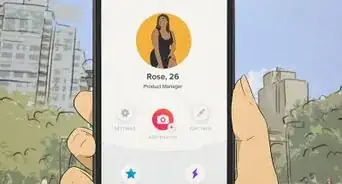 Tinder Hacks You Need to Know: How to Make the Most of the App and Beat the Algorithm
Tinder Hacks You Need to Know: How to Make the Most of the App and Beat the Algorithm
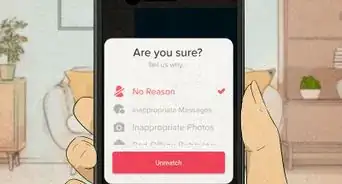



 Tinder Boosts and Superboosts: When Should You Use Them?
Tinder Boosts and Superboosts: When Should You Use Them?




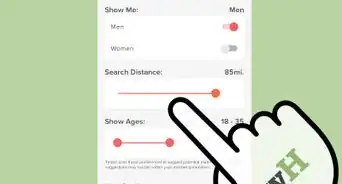

References
- ↑ https://nordvpn.com/blog/tinder-bots/
- ↑ https://isi.edu/~fredmors/paperpdfs/sdm-tinder-2018.pdf
- ↑ https://nordvpn.com/blog/tinder-bots/
- ↑ https://nordvpn.com/blog/tinder-bots/
- ↑ https://nordvpn.com/blog/tinder-bots/
- ↑ https://isi.edu/~fredmors/paperpdfs/sdm-tinder-2018.pdf
- ↑ https://isi.edu/~fredmors/paperpdfs/sdm-tinder-2018.pdf
- ↑ https://medium.com/@dateaha/spot-the-bot-keep-bots-from-taking-over-on-dating-sites-6fe64e445dc0
- ↑ https://medium.com/@dateaha/spot-the-bot-keep-bots-from-taking-over-on-dating-sites-6fe64e445dc0
- ↑ https://www.theguardian.com/technology/2014/apr/03/tinder-bots-malicious-downloads-bitdefender
- ↑ https://medium.com/@dateaha/spot-the-bot-keep-bots-from-taking-over-on-dating-sites-6fe64e445dc0
- ↑ https://splinternews.com/hot-or-bot-how-to-tell-if-your-tinder-match-is-a-real-1793850272
- ↑ https://splinternews.com/hot-or-bot-how-to-tell-if-your-tinder-match-is-a-real-1793850272
- ↑ https://medium.com/@dateaha/spot-the-bot-keep-bots-from-taking-over-on-dating-sites-6fe64e445dc0
- ↑ https://nordvpn.com/blog/tinder-bots/
- ↑ https://medium.com/@dateaha/spot-the-bot-keep-bots-from-taking-over-on-dating-sites-6fe64e445dc0
About This Article

1. Read their profile carefully.
2. Look through their photos.
3. Avoid profiles with weird links.
